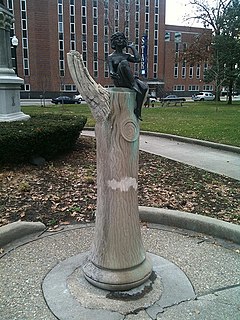Related Research Articles

A pan flute is a musical instrument based on the principle of the closed tube, consisting of multiple pipes of gradually increasing length. Multiple varieties of pan flutes have been popular as folk instruments. The pipes are typically made from bamboo, giant cane, or local reeds. Other materials include wood, plastic, metal and ivory.

In classical Greek mythology, Syrinx was a nymph and a follower of Artemis, known for her chastity. Pursued by the amorous god Pan, she ran to a river's edge and asked for assistance from the river nymphs. In answer, she was transformed into hollow water reeds that made a haunting sound when the god's frustrated breath blew across them. Pan cut the reeds to fashion the first set of panpipes, which were thenceforth known as syrinx. The word syringe was derived from this word.

Syringomyelia is a generic term referring to a disorder in which a cyst or cavity forms within the spinal cord. Often, syringomyelia is used as a generic term before an etiology is determined. This cyst, called a syrinx, can expand and elongate over time, destroying the spinal cord. The damage may result in loss of feeling, paralysis, weakness, and stiffness in the back, shoulders, and extremities. Syringomyelia may also cause a loss of the ability to feel extremes of hot or cold, especially in the hands. It may also lead to a cape-like bilateral loss of pain and temperature sensation along the upper chest and arms. Each patient experiences a different combination of symptoms. These symptoms typically vary depending on the extent and, often more critically, on the location of the syrinx within the spinal cord.
In Greek mythology, Syrinx was a nymph who was transformed into water reeds that were then fashioned into a musical instrument by the god Pan.

The vocal tract is the cavity in human bodies and in animals where the sound produced at the sound source is filtered.

Louis Fleury was a French flautist, pupil of Paul Taffanel at the Paris Conservatoire. Claude Debussy dedicated the piece for solo flute Syrinx to him in 1913, and Fleury performed the première. In 1921 English composer Cyril Rootham dedicated to Louis Fleury a "Suite in Three Movements" for flute and piano.

Vegavis is a genus of extinct bird that lived during the Late Cretaceous of Antarctica, some 68 to 66 mya. Among modern birds, most studies show that Vegavis is most closely related to ducks and geese (Anatidae), but it is not considered to be a direct ancestor of them, although other studies question these results.
Syrinx, L. 129, is a piece of music for solo flute which Claude Debussy wrote in 1913. It generally takes three minutes or less to perform. It was the first significant piece for solo flute after the Sonata in A minor composed by C. P. E. Bach over 150 years before (1747), and it is the first such solo composition for the modern Böhm flute, developed in 1847.

John Mills-Cockell is a Canadian composer and multi-instrumentalist, perhaps best known for his ground-breaking work with progressive / avant garde Canadian groups Intersystems and Syrinx, and for his numerous works for radio, television, film, ballet, and stage.

The syrinx is the vocal organ of birds. Located at the base of a bird's trachea, it produces sounds without the vocal folds of mammals. The sound is produced by vibrations of some or all of the membrana tympaniformis and the pessulus, caused by air flowing through the syrinx. This sets up a self-oscillating system that modulates the airflow creating the sound. The muscles modulate the sound shape by changing the tension of the membranes and the bronchial openings. The syrinx enables some species of birds to mimic human speech. Unlike the larynx in mammals, the syrinx is located where the trachea forks into the lungs. Thus, lateralization is possible, with muscles on the left and right branch modulating vibrations independently so that some songbirds can produce more than one sound at a time. Some species of birds, such as New World vultures, lack a syrinx and communicate through throaty hisses.
3360 Syrinx is an Apollo and Mars crosser asteroid discovered in 1981. It approaches Earth to within 40 Gm three times in the 21st century: 33 Gm in 2039, 40 Gm in 2070, and 24 Gm in 2085.

Rush Replay X 3 is a DVD box set of three separate filmed concert presentations by the Canadian band Rush, released on June 13, 2006. The three shows presented are Exit... Stage Left, Grace Under Pressure Tour, and A Show of Hands, which were originally released individually in 1982, 1985, and 1989 respectively on VHS and Laserdisc. For Replay X 3, each filmed concert has been remixed in 5.1 surround sound by Rush guitarist and co-producer Alex Lifeson. The box set also includes a previously unreleased CD audio version of the Grace Under Pressure Tour video, and a set of reprinted tour books for each concert. Rush Replay X 3 debuted at #1 on the Billboard Music Video charts, making it the third consecutive Rush DVD release to reach #1 on that particular Billboard chart, after Rush in Rio (2003) and R30 (2005)..
A syrinx is a rare, fluid-filled neuroglial cavity within the spinal cord (syringomyelia), in the brain stem (syringobulbia), or in the nerves of the elbow, usually in a young age.

The Short L.17 Scylla was a British four-engined 39-seat biplane airliner designed and built by Short Brothers at the request of Imperial Airways to supplement the Handley Page H.P.42 fleet already in service after Handley Page quoted an excessive price for two additional H.P.42s. They were ordered in 1933.
Syrinx was a Canadian electronic music group active from 1970 to 1972. Propelled by the compositions of keyboardist John Mills-Cockell and backed by saxophonist Doug Pringle and percussionist Alan Wells, the group broke musical ground with their innovative use of the Moog synthesizer and their world music inspirations. Their song "Tillicum" received national attention as the theme music for the television series Here Come the Seventies.
Passerine birds produce song through the vocal organ, the syrinx, which is composed of bilaterally symmetric halves located where the trachea separates into the two bronchi. Using endoscopic techniques, it has been observed that song is produced by air passing between a set of medial and lateral labia on each side of the syrinx. Song is produced bilaterally, in both halves, through each separate set of labia unless air is prevented from flowing through one side of the syrinx. Birds regulate the airflow through the syrinx with muscles—M. syringealis dorsalis and M. tracheobronchialis dorsalis—that control the medial and lateral labia in the syrinx, whose action may close off airflow. Song may, hence, be produced unilaterally through one side of the syrinx when the labia are closed in the opposite side.

Syrinx aruanus, common name the Australian trumpet or false trumpet, is a species of extremely large sea snail measuring up to 91 cm long and weighing up to 18 kg. It is a marine gastropod mollusk in the family Turbinellidae, and is the only species in the genus Syrinx.

Syrinx is a 1973 public artwork by German-born American sculptor Adolph Wolter located at the Indiana World War Memorial Plaza in Indianapolis, Indiana, United States.
Carl Nielsen's Pan and Syrinx is a symphonic poem written for a concert of the composer's works which was held on 11 February 1918 in Copenhagen.

Onciderini is a tribe of longhorn beetles of the subfamily Lamiinae, they are prevalent across Europe in nations such as Turkey, and Finland.
References
- ↑ BioLib.cz - Plerodia syrinx. Retrieved on 8 September 2014.